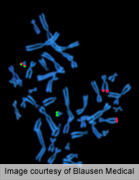 A service of the U.S. National Library of Medicine
A service of the U.S. National Library of Medicine  National Institutes of Health
National Institutes of Health

Gene Study Yields New Clues to Breast Cancer

SUNDAY, Sept. 23 (HealthDay News) -- A comprehensive look at the genetic blueprint of breast cancer has revealed new insights into the disease -- including the discovery that certain breast and ovarian tumors may be closely related.
Basal-like breast tumors -- one of the most deadly subtypes of breast cancer -- are genetically more similar to ovarian cancer than to other breast cancers, the new research found.
In this study, the scientists used six different technologies to analyze 348 tumors from women with breast cancer. They looked for defects in DNA, RNA and proteins in the tumors.
They confirmed the existence of four main subtypes of breast cancer -- luminol A, luminal B, HER2 and basal-like -- and found unique genetic and molecular signatures within each of the subtypes.
The findings add to growing evidence suggesting that tumors should be catalogued and treated based on the genes that are disrupted rather than their location in the body, the researchers said.
"With this study, we're one giant step closer to understanding the genetic origins of the four major subtypes of breast cancer," study co-leader Dr. Matthew Ellis, chair of medical oncology at Washington University School of Medicine in St. Louis, said in a university news release.
One oncologist said the findings on breast cancer's diversity echo her own experience in treating patients.
"The diversity of breast cancer is instinctual to a practicing breast surgeon who has seen women with breast cancer, presumably the same stage, have differing outcomes with respect to recurrence and survival," said Dr. Donna-Marie Manasseh, director of breast surgery at the Maimonides Breast Cancer Center in New York City. "This research validates what we have suspected."
According to Ellis, the new study suggests that most basal-like breast tumors and ovarian tumors have similar genetic origins and potentially could be treated with the same drugs.
Basal-like tumors account for about 10 percent of all breast cancers and disproportionately affect younger and black women in the United States. Basal-like tumors include most triple-negative breast tumors, which are often aggressive and do not respond to therapies that target hormone receptors or to standard chemotherapies.
"Now, we can investigate which drugs work best for patients based on the genetic profiles of their tumors. For basal-like breast tumors, it's clear they are genetically more similar to ovarian tumors than to other breast cancers. Whether they can be treated the same way is an intriguing possibility that needs to be explored," Ellis explained.
Another expert agreed that this type of insight moves medicine closer to a "personalized" approach to therapy.
"This research is geared toward finding ways to individualize cancer treatment," said Dr. Stephanie Bernik, chief of surgical oncology at Lenox Hill Hospital in New York City. "When treating breast cancer, we offer specific therapies that have been tested on large populations of cancer patients. However, one treatment is not necessarily good for all."
According to Bernik, "this research helps move us to the point where we will look at a tumor's genetic makeup and tailor a specific treatment that will attack the tumor cells based on the tumor's genetic fingerprint."
Manasseh said the new study "provides hope to many woman and clinicians who battle breast cancer every day."
"Breast cancer is not just one disease and, therefore, requires not just one type of therapy but rather different disease types that require specific therapies targeted for each type," she added. "Targeted therapies allow for more effective treatment of tumors, while minimizing the treatment of tumors with less effective therapies and their subsequent side effects."
The study was published online Sept. 23 in the journal Nature.
SOURCES: Donna-Marie Manasseh, M.D., director, breast surgery, Maimonides Breast Cancer Center, New York City; Stephanie Bernik, M.D., chief, surgical oncology, Lenox Hill Hospital, New York City; Washington University School of Medicine, news release, Sept. 23, 2012
- More Health News on:
- Breast Cancer
- Genes and Gene Therapy